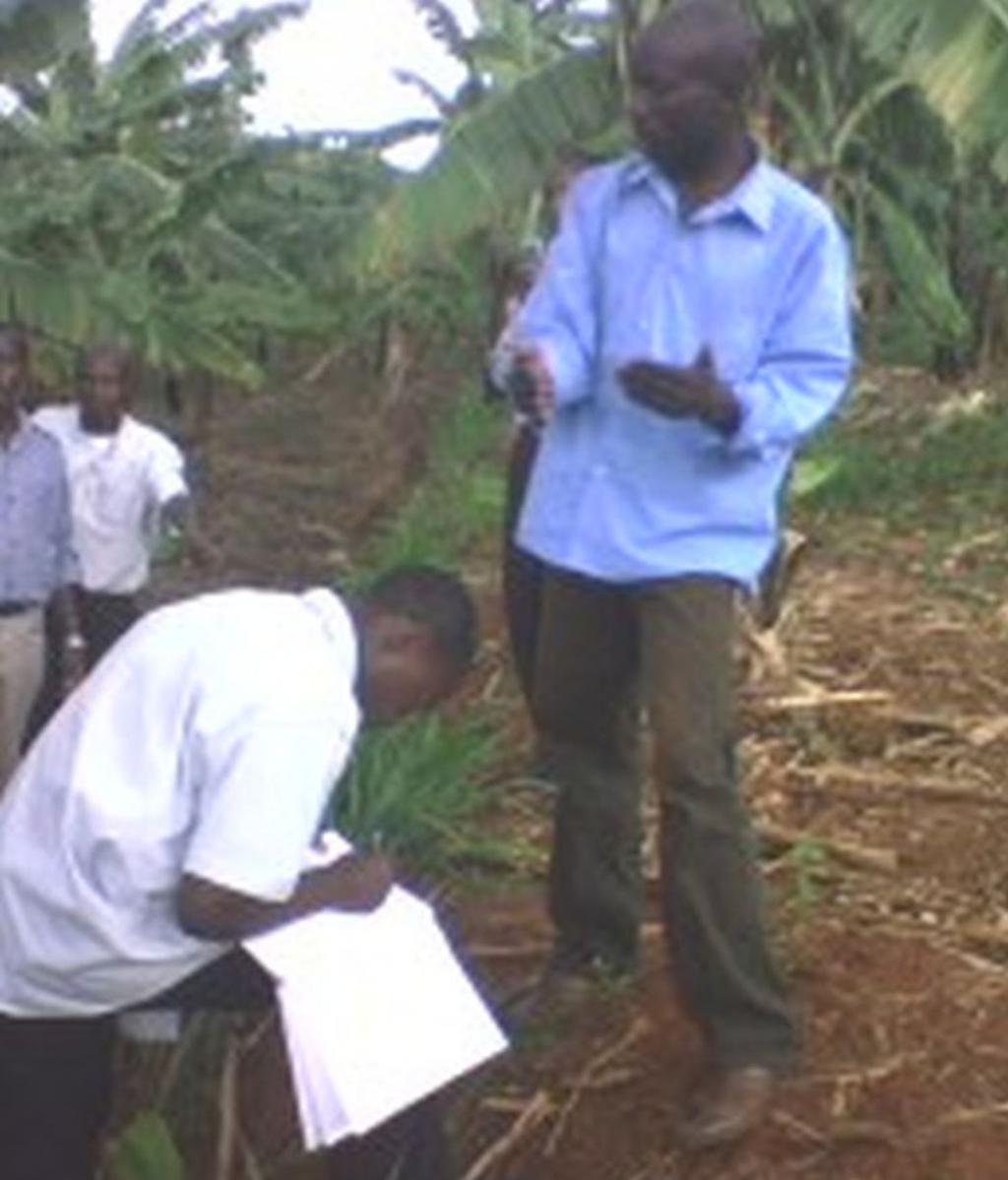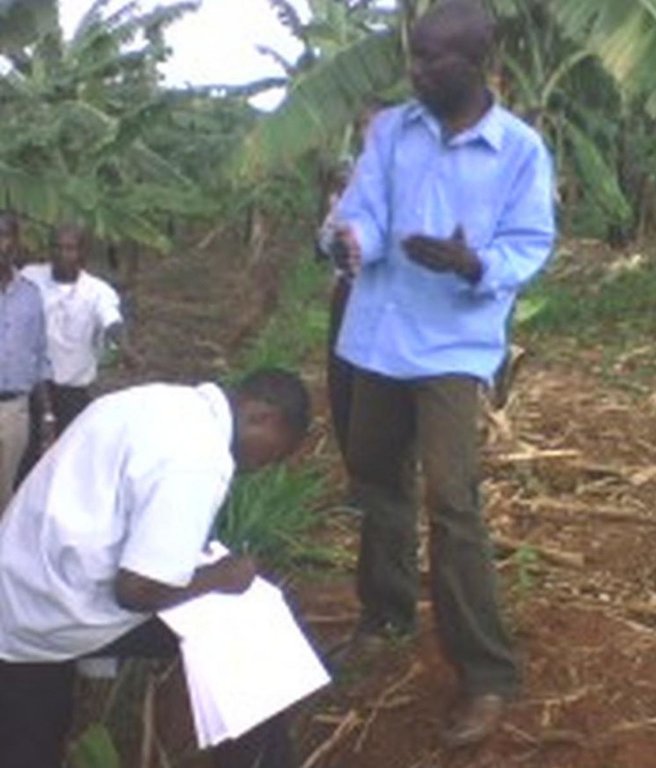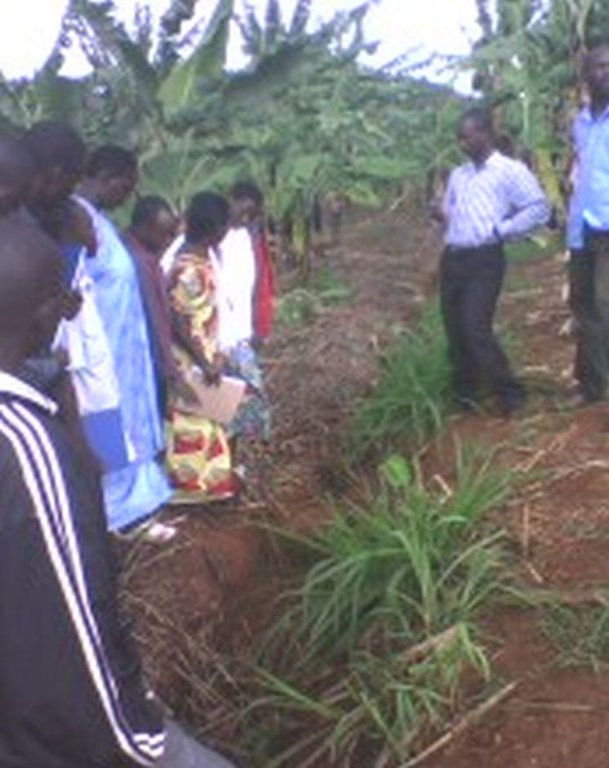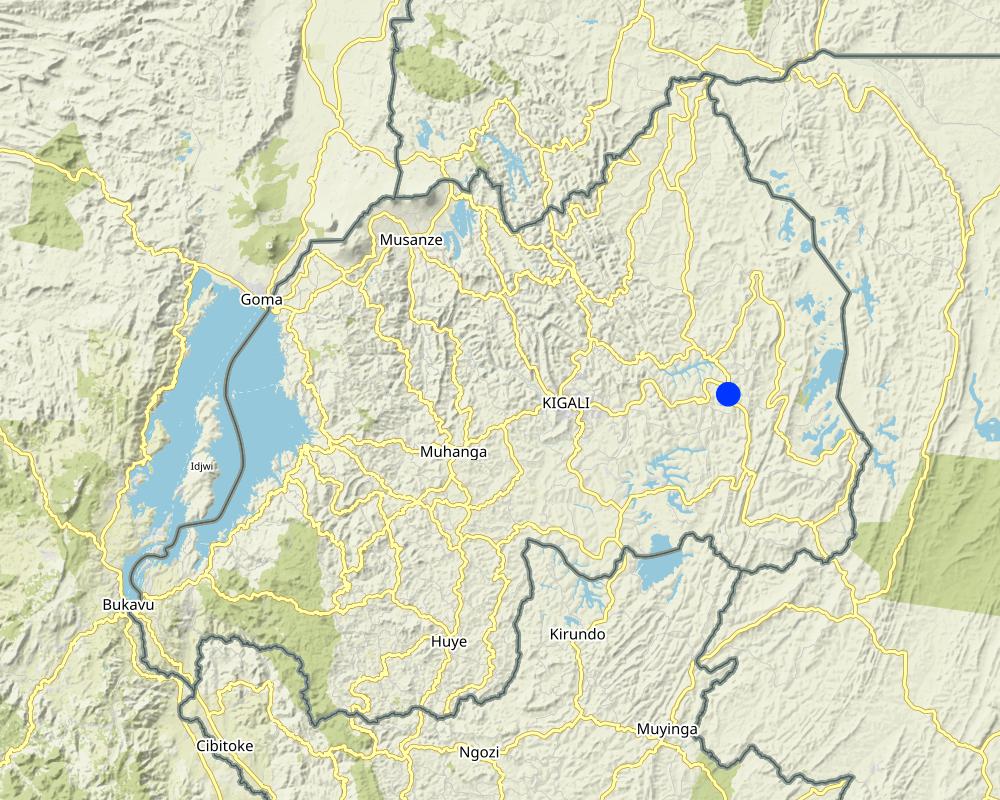Spontaneous farmer to farmer adoption [Rwanda]
- Création :
- Mise à jour :
- Compilateur : Desire Kagabo
- Rédacteur : –
- Examinateurs : David Streiff, Joana Eichenberger
Kwigira ku bandi
approaches_2585 - Rwanda
Voir les sections
Développer tout Réduire tout1. Informations générales
1.2 Coordonnées des personnes-ressources et des institutions impliquées dans l'évaluation et la documentation de l'Approche
Spécialiste GDT:
Nom du projet qui a facilité la documentation/ l'évaluation de l'Approche (si pertinent)
The Transboundary Agro-ecosystem Management Project for the Kagera River Basin (GEF-FAO / Kagera TAMP )Nom du ou des institutions qui ont facilité la documentation/ l'évaluation de l'Approche (si pertinent)
Rwanda Agriculture Board (Rwanda Agriculture Board) - RwandaNom du ou des institutions qui ont facilité la documentation/ l'évaluation de l'Approche (si pertinent)
FAO Food and Agriculture Organization (FAO Food and Agriculture Organization) - Italie1.3 Conditions relatives à l'utilisation par WOCAT des données documentées
Le compilateur et la(les) personne(s) ressource(s) acceptent les conditions relatives à l'utilisation par WOCAT des données documentées:
Oui
2. Description de l'Approche de GDT
2.1 Courte description de l'Approche
Diffusion of sustainable land management technologies through an effective farmer-to-farmer diffusion approach
2.2 Description détaillée de l'Approche
Description détaillée de l'Approche:
Aims / objectives: Knowledge sharing through observation and experiments of self motivated individual farmers. The spillover of a technology/practice among farmers is simply motivated by good yield and other production factors of the technologies.
Methods: Farmer to farmer learning and adoption of new products/technology
Stages of implementation: Existing of best and new technologies, curiosity of farmers about the new product, experiment of the new products and adoption.
2.3 Photos de l'approche
2.5 Pays/ région/ lieux où l'Approche a été appliquée
Pays:
Rwanda
Région/ Etat/ Province:
East
Autres spécifications du lieu :
Kirehe
Commentaires:
The area is approximately well known
Map
×2.6 Dates de début et de fin de l'Approche
Indiquez l'année de démarrage:
1940
2.7 Type d'Approche
- traditionnel/ autochtone
2.8 Principaux objectifs de l'Approche
The Approach focused mainly on SLM with other activities (maintenance of soil moisture and soil fertility)
Learning from others' experiences.
The SLM Approach addressed the following problems: Low productivity of lands due to poor management of soil and low/none use of agricultural inputs. In addition, the problem is aggravated by inadequate soil erosion control measures.
2.9 Conditions favorisant ou entravant la mise en œuvre de la(des) Technologie(s) appliquée(s) sous l'Approche
disponibilité/ accès aux ressources et services financiers
- entrave
Lack of resources especially for soil erosion technologies that require heavy investments and mobilization of all stakeholders
Treatment through the SLM Approach: Government support is required.
cadre juridique (régime foncier, droits d'utilisation des terres et de l'eau)
- favorise
- entrave
connaissances sur la GDT, accès aux supports techniques
- entrave
Soil fertility decline and soil degradation due to a lack of knowledge and resource in soil fertility management and on a better agriculture practice in banana field.
Treatment through the SLM Approach: Creation of Innovation Platforms, watershed management committees, etc.
3. Participation et rôles des parties prenantes impliquées dans l'Approche
3.1 Parties prenantes impliquées dans l'Approche et rôles
- exploitants locaux des terres / communautés locales
Innovative land users make a promotion of a technology and other farmers learn from them.
Farmers explains each other about a technology
3.2 Participation des exploitants locaux des terres/ communautés locales aux différentes phases de l'Approche
| Participation des exploitants locaux des terres/ communautés locales | Spécifiez qui était impliqué et décrivez les activités | |
|---|---|---|
| initiation/ motivation | auto-mobilisation | Individual farmers by simple observation of what is happening in the neighborhood. |
| planification | auto-mobilisation | Individual initiative and this starts by curiosity and awareness. A self motivated farmer approaches the owner of promising agricultural technologies/practices for more details. |
| mise en œuvre | auto-mobilisation | There is no formal model |
| suivi/ évaluation | auto-mobilisation | |
| Research | passive |
3.4 Prises de décision pour la sélection de la Technologie/ des Technologies
Indiquez qui a décidé de la sélection de la Technologie/ des Technologies à mettre en œuvre:
- les exploitants des terres seuls (auto-initiative)
Expliquez:
Innovative land users make a promotion of a technology and other farmers learn from them.
Decisions on the method of implementing the SLM Technology were made by by land users* alone (self-initiative / bottom-up)
4. Soutien technique, renforcement des capacités et gestion des connaissances
4.1 Renforcement des capacités/ formation
Une formation a-t-elle été dispensée aux exploitants des terres/ autres parties prenantes?
Oui
Spécifiez qui a été formé:
- exploitants des terres
Formats de la formation:
- entre agriculteurs (d'exploitants à exploitants)
- zones de démonstration
Thèmes abordés:
soil moisture conservation and soil fertility improvement
4.2 Service de conseils
Les exploitants des terres ont-ils accès à un service de conseils?
Oui
Spécifiez si le service de conseils est fourni:
- dans les champs des exploitants?
Décrivez/ commentez:
Name of method used for advisory service: Extension; Key elements: farmer to farmer exchange visit
Advisory service is very adequate to ensure the continuation of land conservation activities; the impact of the technology on production is very high.
4.3 Renforcement des institutions (développement organisationnel)
Des institutions ont elles été mises en place ou renforcées par le biais de l'Approche?
- non
4.4 Suivi et évaluation
Le suivi et l'évaluation font ils partie de l'Approche? :
Oui
Commentaires:
Economic / production aspects were ad hoc monitored by land users through observations; indicators: Farmers observed that the yield increases due to the technology
Area treated aspects were ad hoc monitored by government through observations
No. of land users involved aspects were ad hoc monitored by land users through measurements
There were no changes in the Approach as a result of monitoring and evaluation
There were no changes in the Technology as a result of monitoring and evaluation
4.5 Recherche
La recherche a-t-elle fait partie intégrante de l’Approche?
Non
5. Financement et soutien matériel externe
5.1 Budget annuel de la composante GDT de l'Approche
Si le budget annuel précis n'est pas connu, indiquez une fourchette:
- < 2 000
Commentez (par ex. principales sources de financement/ principaux bailleurs de fonds):
Approach costs were met by the following donors: local community / land user(s) (land users): 90.0%; other (governmental SLM specialist): 10.0%
5.2 Soutiens financiers/ matériels fournis aux exploitants des terres
Les exploitants des terres ont-ils reçu un soutien financier/ matériel pour la mise en œuvre de la Technologie/ des Technologies?
Non
5.3 Subventions pour des intrants spécifiques (incluant la main d'œuvre)
- aucun
Si la main d'œuvre fournie par les exploitants des terres était un intrant substantiel, elle était:
- volontaire
5.4 Crédits
Des crédits ont-ils été alloués à travers l'Approche pour les activités de GDT?
Non
6. Analyses d'impact et conclusions
6.1 Impacts de l'Approche
Est-ce que l'Approche a aidé les exploitants des terres à mettre en œuvre et entretenir les Technologies de GDT?
- Non
- Oui, un peu
- Oui, modérément
- Oui, beaucoup
Most of farmlands in the area and its surrounding have adopted the technology which highly reduced the soil erosion hence the increase of crop yield (probably due to the increasing of soil organic matter content).
Did the Approach lead to improved livelihoods / human well-being?
- Non
- Oui, un peu
- Oui, modérément
- Oui, beaucoup
The approach helped to rapidly adopt the technology which in return improved the crop yield. Due to the efficiency of mulching in reducing soil erosion , the sustainability of land management has improved as a result.
Did the Approach help to alleviate poverty?
- Non
- Oui, un peu
- Oui, modérément
- Oui, beaucoup
In the region, banana crop is a staple crop. However, due to access of new markets in cities, banana is now regarded as a cash crop hence contributing to the increase of farm income.
6.3 Durabilité des activités de l'Approche
Les exploitants des terres peuvent-ils poursuivre ce qui a été mis en œuvre par le biais de l'Approche (sans soutien extérieur)?
- oui
Si oui, décrivez de quelle manière:
Yes because farmers explain by their own to other farmers which facilitate the spreading of any technology quickly
6.4 Points forts/ avantages de l'Approche
| Points forts/ avantages/ possibilités du point de vue de l'exploitant des terres |
|---|
| This approach can carry messages and content on other subjects than S.L.M. only (How to sustain/ enhance this strength: promote the approach as a general grassroots-based extension approach) |
| Points forts/ avantages/ possibilités du point de vue du compilateur ou d'une autre personne ressource clé |
|---|
| Both the service provider and the demand groups are local farmers; this approach therefore directly benefits only the local farming community (How to sustain/ enhance this strength: sensitization ) |
| Technologies adopted through farmer-to-farmer diffusion are likely to be more stable and sustainable because innovative farmers will only disseminate successful technologies (How to sustain/ enhance this strength: sensitization ) |
6.5 Faiblesses/ inconvénients de l'Approche et moyens de les surmonter
| Faiblesses/ inconvénients/ risques du point de vue du compilateur ou d'une autre personne ressource clé | Comment peuvent-ils être surmontés? |
|---|---|
| some farmers are resilient to help other | sensitization and involvement of those resilient farmers in local decision making. |
7. Références et liens
7.1 Méthodes/ sources d'information
- visites de terrain, enquêtes sur le terrain
- interviews/entretiens avec les exploitants des terres
Liens et modules
Développer tout Réduire toutLiens
Aucun lien
Modules
Aucun module trouvé





